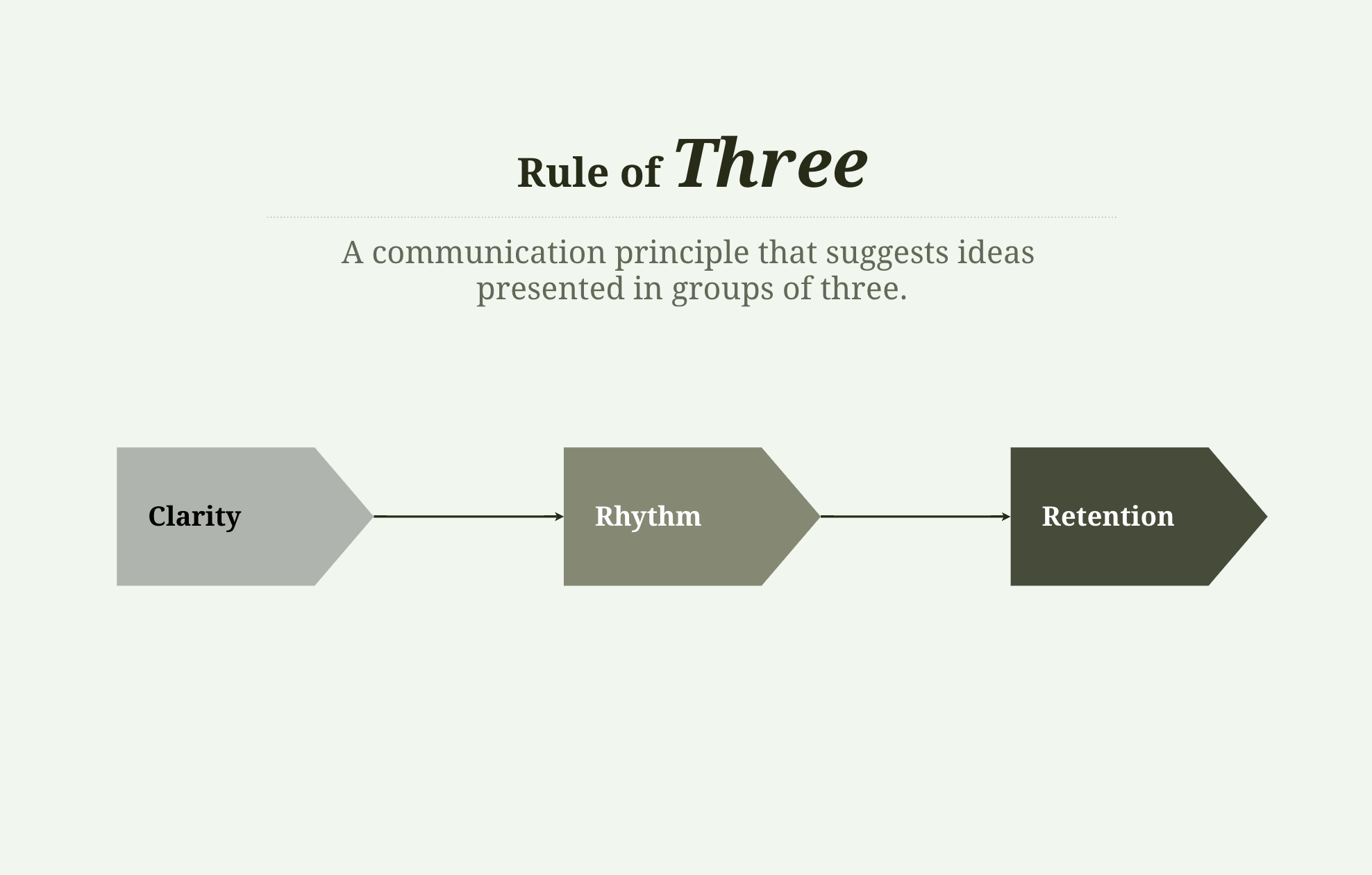Mar 27, 2025
The Rule of Three: Boost Audience Retention in Presentations
Mar 27, 2025
The Rule of Three: Boost Audience Retention in Presentations

Most people only listen with 25% efficiency. The numbers get worse - we only remember half of what we hear and lose half of that information within 48 hours.
The Rule of Three plays a crucial role in making presentations work. People find information in groups of three more captivating, easier to remember, and more enjoyable. Research shows that our brain's working memory can only hold three to five meaningful pieces of information at once.
Want to make your presentations better? Let's see how Xmind can help you become skilled at using the Rule of Three to create presentations your audience won't forget.
What Is Rule of Three?

"Veni, Vidi, Vici" — Julius Caesar, Roman general and statesman
The Rule of Three stands as one of the most powerful principles in communication. This concept makes ideas, concepts, and information more engaging, memorable, and effective when presented in groups of three.
This principle goes way back to Ancient Rome, where they called it "omne trium perfectum" - meaning "everything that comes in threes is perfect". The Greeks had their own version called "hendiatris," which means "one through three" and uses three words to express a single idea.
Cognitive psychology shows us why this works. Our working memory can only process a limited amount of information at once. Harvard Professor George Miller suggested we could retain about seven pieces of information (plus or minus two). Modern scientific research has narrowed this down to three or four pieces. People often feel overwhelmed when you go beyond the three main points.
The Rule of Three works because:
- Three is the smallest number that creates a pattern our pattern-loving brains can recognize
- It gives perfect balance - one item feels insufficient while four or more becomes overwhelming
- It creates a satisfying rhythm and sense of completeness
You'll spot this principle in the most effective communication: "I came, I saw, I conquered" (Julius Caesar) "Life, liberty, and the pursuit of happiness" (Declaration of Independence) "Stop, look, listen" (Safety instruction)
What's more, the Rule of Three makes your presentations more memorable, effective, and funny. Complex ideas become clearer when you present them from three different angles to suit a variety of learning styles. Your audience remembers key points better when you repeat them three times during your presentation.
The Science behind the Rule of Three
The human brain shows amazing abilities but has strict limits. Scientific research reveals our working memory can only handle 3-5 meaningful items at once. This biological limit creates the foundation that makes the rule of three work so well in presentations. Xmind helps you organize your content around this principle and work with—not against—your audience's mental capabilities.
Cognitive load theory and working memory limitations
Cognitive load theory shows how our working memory—where we process information mentally—has strict capacity limits. Harvard psychologist George Miller first suggested we could retain about seven items (plus or minus two). Yet recent research narrows this down to just 3-4 chunks of information. Your audience experiences mental fatigue and decreased performance when presentations go beyond this threshold.
Pattern recognition in the human brain
Our brains look for patterns to understand the world around us. The neocortex—making up 80% of the human brain—contains about 300 million pattern recognizers. This advantage helped our ancestors spot threats and opportunities. Today it shapes how we take in information.
Three stands as the smallest number needed to create a pattern. Cognitive psychologists point out that we might see the first instance as chance and the second as coincidence. The third instance establishes a pattern. Presentations structured in threes tap into this natural pattern-recognition ability. This makes the content easier to digest.
Why three points create the perfect balance
Three strikes the right balance between keeping things simple and adding complexity. Content feels incomplete with fewer than three points but becomes too much with more. This balance explains why audiences connect better with triads.
The three-point structure creates a sense of completeness that feels right psychologically. This approach offers:
- Cognitive efficiency - Maximum retention with minimal mental effort
- Rhythmic satisfaction - A beginning, middle, and end feels complete
- Emotional resonance - Three-part structures engage both logical and emotional brain functions
Creating Mind Maps with Xmind for Rule of Three Planning
Mind mapping gives you a perfect way to use the rule of three in your presentations. Xmind comes with easy-to-use tools that work great with this powerful principle. Your presentations become more engaging and memorable.

Setting up your presentation structure in Xmind
Xmind turns complex ideas into clean, visual maps that your audience can follow easily. Your presentation structure starts with a central topic that shows your main message. Simple keyboard shortcuts make the process smooth - press Tab to create subtopics and Enter to add topics at the same level. This lets you focus on creating content without formatting hassles.
Xmind shines through its simplicity. You won't spend time fixing layouts or moving elements around since the structure builds itself. Pick any of Xmind's 100+ templates as your starting point and shape it to match your presentation needs.
Using branches to develop your three main points
After setting your central topic, create three main branches for your key points. This matches how our brains process information, as I wrote in previous sections. Each branch grows with supporting details while staying clear and organized.
Each branch in Xmind can have its own style. You might use fishbone, matrix, or timeline layouts - all in one mind map. This helps show the rule of three while keeping complex details under each main point without overwhelming anyone.
Your presentation branches should flow logically. Create tension, build it up, and release it - a three-part sequence that makes your ideas stick.
Adding visual elements to enhance memorability
Visual elements make your three main points easier to remember. Xmind gives you several ways to make your content stand out:
Different colors for each of your three branches make them distinct
Icons, stickers, or images highlight important concepts
Images illustrate key points within each branch
Xmind's Pitch Mode takes your presentations up a notch by turning your mind map into a dynamic show. You can zoom into each of your three main sections one by one, creating an engaging experience that drives your message home.
Try Xmind today to build your next presentation around the rule of three.
Implementing the Rule of Three in Different Presentation Types
The rule of three becomes more powerful when you adapt it to specific presentation contexts. Xmind helps you organize these frameworks and create presentations that appeal to any audience type.
Sales presentations: Problem, solution, benefit

A problem-solution-benefit structure serves as the foundation for effective sales presentations. This framework helps audiences move from pain point to resolution. Your first step should identify a specific problem your audience faces. Make it relatable through data or stories. Present your solution as the answer to this challenge. The final part should showcase the actual benefits your solution delivers.
This structure helps buyers focus on their three main business challenges. You should confirm and refine these challenges throughout the sales experience. This positions you as a trusted advisor rather than just another vendor.
Educational presentations: Learn, practice, master

The learn-practice-master approach works best for educational presentations. This framework matches how our brains pick up new skills. Start with clear foundational concepts. Show how to apply them through examples or guided practice. The process ended up with ground implementation.
Students need to see material at least three times before they truly grasp it. Each step naturally builds complexity and helps learners do rather than just watch.
Technical presentations: Context, concept, application

The context-concept-application framework makes technical material more available. Give enough background so people understand why your topic matters. Then introduce your main technical concept with clear explanations of complex terms. The final part should show practical ways to use your concept.
This method prevents overwhelming your audience while keeping your technical presentation complete and connected. Your Xmind maps should follow these three divisions. Create sections that break down information for better understanding.
Xmind can help you use these powerful frameworks in your next presentation.
Rule of Three Examples That Transformed Ordinary Presentations
"Tell me and I forget. Teach me and I remember. Involve me and I learn." — Benjamin Franklin, Founding Father of the United States
The most memorable presentations in history have made use of information from the rule of three to engage audiences and deliver unforgettable messages. We can extract powerful patterns to improve our own presentations by understanding these examples.
Steve Jobs and Apple product launches
Steve Jobs became skilled at the rule of three and used it consistently to introduce Apple's revolutionary products. His return to Apple in 1998 marked a dramatic reduction in the product line. He wanted to make choices simpler for customers because "mere humans" can only handle limited information.
The 2007 iPhone launch showcased his most iconic use of this principle. He announced "three revolutionary products" – an MP3 player, a phone, and an Internet communications device. The audience erupted when he revealed these three components were all part of one device: the iPhone [40, 41].
Yes, it is true that Jobs used the rule of three throughout his career:
The Macintosh introduction in 1984 as "the third industry milestone product"
The iPod launch in 2001 with "three major breakthroughs"
The iPad positioning in 2010 as a "third device" between smartphones and laptops
Jobs structured his legendary 2005 Stanford commencement speech around "three stories from my life".
TED Talks that masterfully use the rule of three
TED Talks often use the rule of three to maximize audience retention. Mark Moore's presentation "The Power of Three" explored this concept through popular culture analogies and Martin Luther King's reference to "length, breadth, and width of life".
Ashley Whillans gave a practical TED Talk titled "3 rules for better work-life balance." She explained how "always-on" work culture damages personal well-being and work quality. Her talk provided three practical steps that help set lasting boundaries.
Ideas on Stage, a presentation coaching company, reports working with thousands of clients since 2010. They've "never seen a presentation that can't be divided into three parts".
Conclusion
The Rule of Three is the quickest way to create memorable presentations that line up with how our brains process information. Research shows that grouping content in threes helps audiences retain more while avoiding mental fatigue.
Steve Jobs showed the amazing effect of this principle in his product launches and speeches. The Rule of Three gives you a solid framework that works for sales pitches, educational content and technical presentations.
Xmind helps you build presentations using this powerful principle with ease. Your next presentation will stick in your audience's mind when you organize it in Xmind. They will connect better with your message and value your clear three-point structure.
FAQs
How does the Rule of Three enhance presentations?
The Rule of Three improves presentations by making information more engaging, memorable, and impactful. It aligns with our brain's natural ability to process and retain information, helping audiences better understand and remember key points.
What are some examples of the Rule of Three in action?
Steve Jobs famously used the Rule of Three in Apple product launches, such as introducing the iPhone as three revolutionary products in one. Many TED Talks also employ this principle, structuring their content around three main ideas or steps to maximize audience retention.
How can I implement the Rule of Three in different types of presentations?
For sales presentations, use the problem-solution-benefit structure. In educational presentations, follow the learn-practice-master approach. For technical presentations, employ the context-concept-application framework. These structures help organize content effectively for different audience needs.
Why is the number three so effective in communication?
Three is the smallest number needed to create a pattern, which our brains naturally seek. It provides a perfect balance between simplicity and complexity, creating a sense of completeness without overwhelming the audience. This makes information more digestible and memorable.
How can Xmind help in applying the Rule of Three to presentations?
Xmind is a mind mapping tool that allows you to visually organize your presentation around three main branches. It offers features like customizable layouts, color coding, and the addition of visual elements, which can enhance the memorability of your three key points and support a more engaging presentation structure
More Posts
AIDA Model: Building Effective Presentations (with Templates)
Learn what AIDA model is and how to apply it in presentations, during which capture attention, build interest, drive desire and prompt action with Xmind.

Master Presentation Storytelling: Simple Techniques to Win Any Audience
Master storytelling technique in presentations, and use Xmind to create engaging, memorable slides that captivate any audience and drive your message home.

8 Best AI Presentation Makers for Quick Slides in 2025
Discover the top AI presentation makers in 2025 for creating fast, professional, and engaging powerpoint slides for presentation effortlessly.


One space for all your ideas
Organize thoughts, visualize structures, connect ideas, and unlock insights.
Get Started for Free


